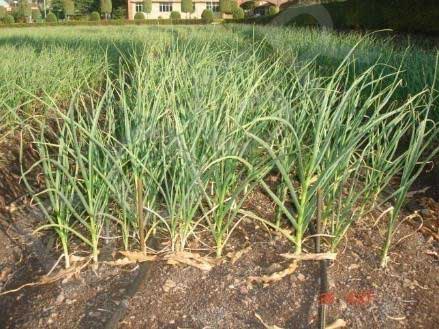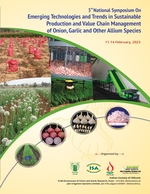Irrigation
Garlic being a very shallow-rooted bulbcrop needs frequent irrigation. It is very sensitive to moisture stress particularly during bulb initiation and bulb development. Garlic crop should be irrigated immediately after planting and subsequently at 7-10 days interval depending upon the soil moisture. In general, kharif crop needs 5-8 irrigations and rabi crop 12-13 irrigations. Irrigation needs to be stopped when the crop attains maturity (10-15 days before harvest). Excess irrigation is always harmful and dry spell followed by irrigation will result in the splitting of the outer scales in garlic. Avoid waterlogged conditions at all stages as these lead to development of diseases like basal rot and purple blotch. Similarly, continuous irrigation towards maturity leads to secondary rooting which, in turn, produces new sprouts and such bulbs cannot be stored for long. With flood irrigation water loss is too high due to conveyance, seepage and percolation losses.
Modern micro-irrigation techniques such as drip and sprinkler irrigation help in saving irrigation water and improve the marketable bulb yield significantly. In case of drip irrigation, seed cloves need to be planted at a spacing of 15 x 10 cm in a broad bed furrow (BBF) of 15 cm height and 120 cm top width with 45 cm furrow. Each BBF should have two drip laterals (16 mm size) at 60 cm distance with inbuilt emitters. The distance between two inbuilt emitters should be around 30-50 cm and the discharge flow rate of 4 l/hr. The drip irrigation system helps in water, labour and fertilizer saving, and improves bulb yield by 15-25% over flood irrigation system.
In case of sprinklers, the distance between two laterals (20 mm size) should be 6 m with a discharge rate of 135 l/hr.


Garlic grown on flat bed with flood irrigation Garlic grown on raised bed with drip irrigation

Garlic grown on flat bed with sprinkler irrigation
Fertigation
Fertigation is an effective and efficient method of applying fertilizers through drip irrigation which is used as the carrier and distributor of irrigation water and crop nutrients. Application of 30 kg nitrogen as basal dose at the time of planting and the remaining in seven equal splits at weekly days interval from planting to 60 DAP through drip irrigation is recommended. Application of nitrogenous fertilizers through drip irrigation system reduces nitrogen losses by leaching into ground water, as in fertigation, fertilizer nutrients are applied in root zone as per the crop requirement thereby improving efficiency of applied fertilizer.















